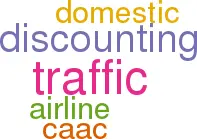Chinese domestic traffic: discounting absolutely forbidden
June 2000


China’s domestic air travel continues to grow at a phenomenal rate, and but it’s far from evolving into a mass transit system. In the recession year 1998 Chinese GDP grew by only 7.8% and passenger traffic growth languished at 6.2%. This year, according to Deutsche Bank, a 13.5% rise in traffic is expected.
The improvement in traffic is attributed to two factors. First, there has been a relaxation in the travel budgets of the state owned enterprises (SOEs). Managers of SOEs plus government officials account for about 60- 70% of domestic revenue. Second, traffic growth has regained momentum following a total ban on fare discounting imposed in April 1999.
However, the CAAC has now implemented a new policy of revenue–sharing on routes operated by more than one airline. Airline revenues go directly to the CAAC where they are divided up among the "competing" airline using a formula based on passengers carried, capacity offered and flight schedules.
The aim is gain to discourage any form of ticket discounting. As Hai Lian Cheng, Finance Director of the CAAC, puts it: "If ticket discounting hadn’t been stopped in a timely manner, it would have caused the economic collapse of the industry and might have endangered safety".
Remarkably, some of the smaller airlines are reported to be continuing to discount in order to compete with the main carriers even though they are risking their AOCs.